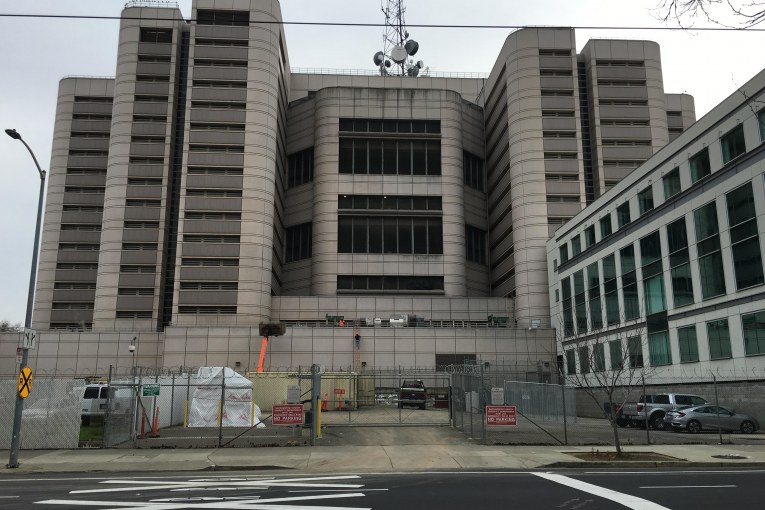
By Anna Zheng
This report is written by the Covid In-Custody Project — an independent journalism project that partners with the Davis Vanguard to report on the pandemic in California’s county jails and Department of Corrections and Rehabilitation (CDCR). Refer to our website to view and download our data.
Several jails and prisons across the United States are overcrowded and house medically vulnerable aging populations. With COVID-19 added to the mix, these conditions have turned deadly. Overcrowding makes social distancing impossible and adds stress to an already broken correctional healthcare system. Advocates and legal scholars have consequently urged courts, legislators and political representatives to reduce the number of people behind bars to make coping with the virus slightly easier.
In California, there are a few instances in which state or federal courts have intervened to further this goal. In one such example, the First District Court of Appeals in In re Ivan Von Staich ordered the California Department of Corrections and Rehabilitation (CDCR), to reduce San Quentin’s population by 50%.
In May 2020, Von Staich filed a writ of habeas corpus alleging that the CDCR was not adequately prepared to respond to the pandemic. The prison had not reported a single positive case until May, but a botched transfer from the CA Institution for Men triggered a massive outbreak affecting over 75% of the population. The design and structure of the 180-year old prison made it impossible to contain the spread.
Following what was termed as the state’s “worst epidemiological disaster,” the state appeals court ordered at least half of San Quentin’s 2,900 residents be transferred or released. This landmark ruling is one of very few decarceration-oriented orders issued in California.
At the county jail level, there have been similar attempts by local courts to reduce the population. The California Judicial Council, for example, established “zero-bail” for low-level non-violent offenses under its Emergency Modified Bail Schedule (EMBS) issued in April 2020.
In Sacramento County, however, records show that the EMBS alone has not been sufficient in reducing overcrowding and protecting medically vulnerable people. There have been no other significant efforts by the county’s Superior Court to reduce the population despite having the opportunity to do so. In fact, the Court heard a habeas petition similar to Von Staich’s, but it was denied.
Since March 2020, the Sacramento County’s Public Defender’s Office has continuously sought a consolidated hearing to examine the jail conditions and to make appropriate orders, such as population reduction. However, the county’s Superior Court has refused to hold such a hearing.
With a population of nearly 3,600 people, the Main Jail and Rio Cosumnes Correctional Center (RCCC) are incarcerating people at a higher rate than what is reasonable during a pandemic. Due to the overcrowded infrastructure, incarcerated residents are unable to comply with social distancing guidelines and unable to minimize the spread of the virus at both facilities.
Both the Main Jail and RCCC have confined a large number of people in double cells and pod or barracks style housing. To enable social distancing, in March 2020, the Sacramento County Public Defender’s Office filed 14 pleadings (7 statutory motions and 7 writs of habeas corpus) seeking the release of over 1,600 people from the jails. They included pretrial detainees, convicted offenders with projected release date, non-convicted sex offenders, and those charged with nonviolent and non-serious offenses. Those who were over 60 years of age and/or had pre-existing medical issues (diabetes, and heart or lung conditions) were also included in the total.
The petitioners were grouped into various categories* based on their charges or projected release dates, and filed for release under a single criminal case with one person chosen as the “lead” petitioner per group.
On June 25, 2020, the total incarcerated population was roughly 2,502 between both the Mail Jail and RCCC. The key habeas petition urged the county to reduce the population to roughly 1,800 people between both institutions. These numbers would allow for single-celling in the Main Jail and appropriate social distancing in “pod” units at the RCCC.
Several public health experts chimed in to support this petition. Dr. Amy Barnhorst, a medical doctor currently working within the jails opined, “Due to the population, inmates cannot be housed in single cells. Rather, majority of inmates are double occupancy in a cell that does not permit for six-foot separation. Continual failure to comply with CDC guidelines will result in a serious medical crisis and put inmates, staff, and Sheriff’s health and safety at risk.”
Bruce Pomer, a public health expert who has served California on nearly every level of public health administration, opined, “the community is at great risk if the jail population is not reduced to single cell occupancy.”
Despite these public health recommendations, the petitioners were all denied release for similar reasons. The Court noted that their arguments were not supported with any facts, specifics of the case, and their backgrounds.
For instance, the Court argued that there was not enough evidence to engage in the required “good cause” analysis. The Court was unable to determine “whether the inmate would present a substantial danger to the public if released, whether the inmate has followed the rules and regulations of the agency housing him, and the nature of the activities in which the inmate hopes to engage once released.” Petitioners, instead, had left it to the Court to investigate the factors for consideration in evaluating whether their release would pose risk to the safety of the community.
Some of the petitioners were incarcerated for “pre-trial felony accusations” and had to remain in custody due to their inability to pay a bond or bail. The Sacramento County Superior Court had allowed them to be safely released to the community upon payment of a bond or bail, however, the amounts were not within their financial means. Thus, the habeas petition sought to release them early.
One such petitioner was accused of a single violation of Vehicle Code Section 10851, charged as felony. He had a prior strike conviction, but had completed his sentence and supervisory period related to the offense. He, however, has remained in confinement because of his inability to afford bail. His bail was set at $115,000, which was outside of his financial means.
The petition argued that the continued pretrial confinement offends both equal protection and due process, and the dollar amount set is excessive in the current economic conditions.
Another group of petitioners were those with release dates between 6/16/20 and 7/31/20 who were double-celled confined. One of them was a 69-year-old woman diagnosed with chronic obstructive pulmonary disease. She suffered from shortness of breath, wheezing, and frequent respiratory infections. She sought for an early release and was denied by the court.
Additionally, one petitioner stated that the nurses did not change their gloves when administering, handling, and providing medication between the quarantined and non-quarantined dorms. The staff also did not enforce any social distancing protocols because “there were too many inmates using the areas to comply with the protocols.”
Three out of four of these petitioners remain confined at the jail facility. Despite the severity and consequences of overcrowding, the Court has taken very minimal action in enabling population reduction.
Unlike Sacramento County, other county courts have taken efforts to release individuals in addition to the zero bail policy.
- In Fresno County, a judicial order allowed the Fresno County Sheriff’s Office to release incarcerated residents who had 30 days or less remaining in their sentence. Over 200 people were released early in March 2020 to create extra space to isolate and quarantine those with COVID-19.
- In Alameda County, the Alameda County district attorney, public defender, and presiding judge agreed to release about 250 people in March 2020 after modifying their sentences. The incarcerated population at the Santa Rita Jail continued to decrease after local courts began releasing defendants under the zero-bail policy. In the span of two weeks, approximately 500 residents were released.
- In San Francisco, the jail population reduced by 25% from 1,100 to 840 as of March 2020. City public health leaders advised that San Francisco should keep a jail population between 700 to 800 to protect individuals at the jail facility from the virus. In response, the San Francisco district attorney, public defender, and courts prioritized early releases for elders, individuals with severe underlying medical conditions, and individuals who do not pose a serious risk of physical violence.
- In Los Angeles, the total incarcerated population decreased by 6% over three weeks as over 1,700 people were released in March 2020. Law enforcement officials sped up efforts to release inmates by prioritizing early releases of those with less than 30 days left to serve and $50,000 bail or less.
Nearly a year after the habeas petition was filed, in January 2022, the jails reported a massive outbreak with active cases soaring from 20 to 120 in just one week. In response to the omicron surge, the Sheriff’s Office announced that since the Emergency Bail Schedule (EMBS) is no longer active, they would release 203 incarcerated residents who have less than 90 days on their sentence from both the Main Jail and RCCC to create adequate quarantine spaces to prevent further spread of the virus.
These early releases will follow the same criteria listed in the January 2021 Sacramento Superior Court order. Without the EMBS active, the jail facilities may face overcrowding until other methods of population reduction are implemented.
The Inspector General for Sacramento County stated in a report published in December of last year that “the jails are overcrowded and there is not enough space to limit the potential for COVID-19 exposure.” If population reduction remains unsought, the health and safety of incarcerated residents will continue to be at risk.
The Sacramento County’s Public Defender’s office has reviewed over 60 declarations and questionnaires submitted on behalf of incarcerated residents confined in the Sacramento County Jail System. The questionnaire consisted of written questions that asked about the conditions inside the jail facilities. Both sources revealed that the incarcerated population were unable to comply with social distancing guidelines due to the facilities’ population and regulations.
This issue with overcrowding continues to persist in the Sacramento County Jail System. It will only proliferate the spread of the virus and continue to put incarcerated residents at high risk.
Appendix
*These individuals were grouped based on the following:
- “certain pre-trial felony accusations”
- “certain pre-trial misdemeanor accusations”
- convicted persons with a projected release between 3/24/20 and 5/15/20
- convicted persons with a projected release between 5/15/20 and 6/15/20
- convicted persons with a projected released between 6/16/20 and 7/31/20
- convicted persons with a projected release between 8/1/20 and 12/31/20
- convicted persons with a projected release between 1/1/21 and 3/31/21
The petitioners who were pre-trial and accused of felonies, sought a writ of habeas corpus on April 2, 2020. The other 6 out of 7 groups were incorporated within this writ, and their habeas petitions are no longer active as a result.




